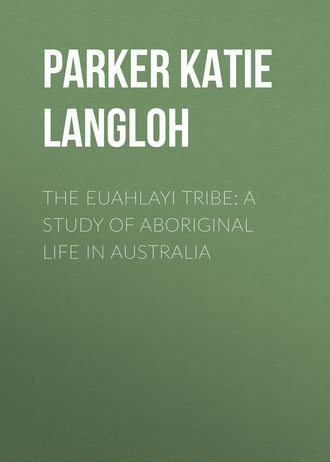 полная версия
полная версияThe Euahlayi Tribe: A Study of Aboriginal Life in Australia
Certainly woman is given a high place in their sacred lore. The chief wife of Byamee, Birrahgnooloo, is claimed as the mother of all, for she, like him, had a totem for each part of her body; no one totem can claim her, but all do.
Mother of all, though mother of none in particular, she was not to be vulgarised by ordinary domestic relations, For those purposes Cunnumbeillee was at hand, as a bearer of children and a caterer. Yet it was Birrahgnooloo whom Byamee best loved and made his companion, giving her power and position which no other held. She too, like him, is partially crystallised in the sky-camp, where they are together; the upper parts of their bodies are as on earth; to her, those who want floods go, and when willing to grant their requests, she bids Cunnumbeillee start the flood-ball of flood rolling down the mountains. Cunnumbeillee, as has been said, had but one totem which her children derived from her.
Byamee is the originator of things less archaic and important than totemism. There is a large stone fish-trap at Brewarrina, on the Barwan River. It is said to have been made by Byamee and his gigantic sons, just as later Greece attributed the walls of Tiryns to the Cyclops, or as Glasgow Cathedral has been explained in legend as the work of the Picts. Byamee also established the rule that there should be a common camping-ground for the various tribes, where, during the fishing festival, peace should be strictly kept, all meeting to enjoy the fish, and do their share towards preserving the fisheries.
Byamee still exists. I have been told by an old native, as will be shown later, that prayers for the souls of the dead used to be addressed to Byamee at funerals; certainly not a practice derived from Protestant missionaries.
Byamee is supposed to listen to the cry of an orphan for rain. Such an one has but to run out when the clouds are overhead, and, looking at the sky, call aloud
'Gullee boorboor. Gullee boorboor.'
'Water come down. Water come down.'
Or should it be raining too much, the last possible child of a woman can stop it by burning Midjeer wood.
Bootha told me after one rain that she had sent one of her tutelary spirits to tell Boyjerh – Byamee is called by women and children Boyjerh – that the country wanted rain. In answer he had taken up a handful of crystal pebbles and thrown them from the sky down into the water in a stone basin on the top of the sacred mountain; as the pebbles fell in, the water splashed up into the clouds above, whence it descended as the desired rain.
It is told to me, that at some initiatory rites the oldest medicine man, or Wirreenun, present addresses a prayer to Byamee, asking him to give them long life, as they have kept his law.
The tribesmen do not profess to pray, or to have prayed, to Byamee on any occasions except at funerals, and at the conclusion of the Boorah.
As for Byamee's relation to ethics, it will be stated in the chapter on the tribal ceremonies, while the stories as to the rewards and punishments of the future life will be given in their place. Baiame's troubles with a kind of disobedient deputy, Darramulun, will also be narrated: the myth is current, too, among the Wir djuri tribe.
Other particulars about Byamee will occur in the course of later chapters: here I have tried to give a general summary of the native beliefs. The reader may interpret them in his own fashion, and may decide as to whether the beliefs do or do not indicate a kind of 'religion,' whether 'a recognised religion' or not. There is necessarily, of course, an absence of temples and of priests, and I have found no trace or vestige of sacrifice. What may be said on the affirmative side as to the religious aspect of the belief, the reader can supply from the summary of facts. Other potent beings occur in native myth, as we shall show, but there appears to exist between them and mankind no relation of affection, reverence, or duty, as in the case of Byamee.
Here it seems necessary to advert to a remark of Mr. Howitt's which appears to be erroneous. He says 'that part of Australia which I have indicated as the habitat of that belief' (namely, in an All Father),' is also the area where there has been the advance from group marriage to individual marriage; from descent in the female line to that in the male line; where the primitive organisation under the class system has been more or less replaced by an organisation based on locality; in fact, where these advances have been made to which I have more than once drawn attention.'[Howitt, NATIVE TRIBES OF SOUTH-EAST AUSTRALIA, p. 500.]
Mr. Howitt forgets that he himself attributes the early system of descent through women, and also the belief in an All Father (Nurelli), to the Wiimbaio tribe [IBID. p. 489] to the Wotjobaluk tribe,[NATIVE TRIBES OF SOUTH-EAST AUSTRALIA, pp. 120, 490.] to the Kamilaroi, to the Ta-Ta-thi,[IBID. p. 494] while female descent and the belief in Baiame mark the Euahlayi and Wir djuri. [JOURNAL, ANTHROPOLOGICAL INSTITUTE, XXV., p. 297.]
These tribes cover an enormous area of country, and, though they have not advanced to male kinship, they all possess the belief in an All Father. That belief does not appear to be in any way associated with advance in social organisation, for Messrs. Spencer and Gillen cannot find a trace of it in more than one of the central and northern tribes, which have male kinship, and a kind of local self-government. On the other hand, it does occur among southern tribes, like the Kurnai, which have advanced almost altogether out of totemism.
In short, we have tribes with female descent, such as the Dieri and Urabunna, to whom all knowledge of an All Father is denied. We have many large and important tribes with female descent who certainly believe in an All Father. We have tribes of the highest social advancement who are said to show no vestige of the belief, and we have tribes also socially advanced who hold the belief with great vigour. In these circumstances, authenticated by Mr. Howitt himself, it is impossible to accept the theory that belief in an All Father is only reached in the course of such advance to a higher social organisation as is made by tribes who reckon descent in the male line.
CHAPTER III
RELATIONSHIPS AND TOTEMS
Some savants question the intellectual ability of the blacks because they have not elaborate systems of numeration and notation, which in their life were quite unneeded. Such as were needed were supplied. They are often incorporate in one word-noun and qualifying numerical adjective, as for example —
Gundooee A SOLITARY EMU
Booloowah TWO EMUS
Oogle oogle FOUR EMUS
Gayyahnai FIVE OR SIX EMUS
Gonurrun FOURTEEN OR FIFTEEN EMUS.
I fancy the brains that could have elaborated their marriage rules were capable of workaday arithmetic if necessary, and few indeed of us know our family trees as the blacks know theirs.
Even the smallest black child who can talk seems full of knowledge as to all his relations, animate and inanimate, the marriage taboos, and the rest of their complicated system.
The first division among this tribe is a blood distinction (I phratries'): —
Gwaigulleeah LIGHT BLOODED
Gwaimudthen DARK BLOODED.
This distinction is not confined to the human beings of the tribe, who must be of one or the other, but there are the Gwaigulleeah and Gwaimudthen divisions in all things. The first and chief division in our tribe, as regards customary marriage law, is the partition of all tribes-folk into these 'phratries,' or 'exogamous moieties.' While in most Australian tribes the meanings of the names of phratries are lost, where the meanings are known they are usually names of animals – Eagle, Hawk, and Crow, White Cockatoo and Black Cockatoo, and so forth. Among the great Kamilaroi tribe, akin in speech to the Euahlayi, the names of phratries, DILBI and KUPATHIN, are of unknown significance. The Euahlayi names, we have seen, are Gwaigulleeah, Light blooded, and Gwaimudthen, Dark blooded.
The origin of this division is said to be the fact that the original ancestors were, on the one side, a red race coming from the west, the Gwaigulleeah; on the other, a dark race coming from the east.
A Gwaigulleeah may under no circumstances marry a Gwaigulleeah; he or she must mate with a Gwaimudthen. This rule has no exception. A child belongs to the same phratry as its mother.
The next name of connection is local, based on belonging to one country or hunting-ground; this name a child takes from its mother wherever it may happen to be born. Any one who is called a Noongahburrah belongs to the Noongah-Kurrajong country; Ghurreeburrah to the orchid country; Mirriehburrah, poligonum country; Bibbilah, Bibbil country, and so on. This division, not of blood relationship, carries no independent marriage restriction, but keeps up a feeling equivalent to Scotch, Irish, or English, and is counted by the blacks as 'relationship,' but not sufficiently so to bar marriage.
The next division is the name in common for all daughters, or all sons of one family of sisters. The daughters take the name from their maternal grandmother, the sons from their maternal great-uncle.
Of these divisions, called I Matrimonial Classes, there are four for each sex, bearing the same names as among the Kamilaroi. The names are —
Masculine Kumbo BROTHER AND SISTER
Feminine, Bootha
Masculine Murree BROTHER AND SISTER
Feminine, Matha
Masculine Hippi BROTHER AND SISTER
Feminine, Hippitha
Masculine Kubbee BROTHER AND SISTER
Feminine, Kubbootha
The children of Bootha will be
Masculine Hippi BROTHER AND SISTER
Feminine, Hippitha
The children of Matha will be
Masculine Kubbee BROTHER AND SISTER
Feminine, Kubbootha
The children of Hippatha will be
Masculine Kumbo BROTHER AND SISTER
Feminine, Bootha
The children of Kubbootha will be
Masculine Murree BROTHER AND SISTER
Feminine, Matha
Thus, you see, they take, if girls, their grandmother's and her sisters' 'class' names in common; if boys, the 'class' name of their grandmother's brothers.
Bootha can only marry Murree,
Matha can only marry Kumbo,
Hippitha can only marry Kubbee,
Kubbootha can only marry Hippi.
Both men and women are often addressed by these names when spoken to.
A PROPOS of names, a child is never called at night by the same name as in the daytime, lest the 'devils' hear it and entice him away.
Names are made for the newly born according to circumstances; a girl born under a Dheal tree, for example, was called Dheala. Any incident happening at the time of birth may gain a child a name, such as a particular lizard passing. Two of my black maids were called after lizards in that way: Barahgurree and Bogginbinnia.
Nimmaylee is a porcupine with the spines coming; such an one having been brought to the camp just as a girl was born, she became Nimmaylee.
The mothers, with native politeness, ask you to give their children English names, but much mote often use in familiar conversation either the Kumbo Bootha names, or others derived from place of birth, from some circumstance connected with it, a child's mispronunciation of a word, some peculiarity noticed in the child, or still more often they call each other by the name proclaiming the degree of relationship.
For example, a girl calls the daughters of her mother and of her aunts alike sisters.
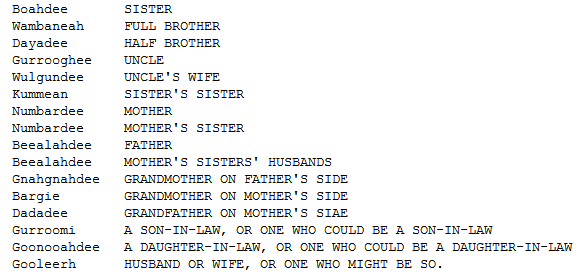
So relationships are always kept in their memories by being daily used as names. There are other general names, too, such as —

Another list of names used ordinarily is —

Those of the same totem are reckoned as brothers and sisters, so cannot intermarry. 'Boyjerh' relations, as those on the father's side are called, are not so important as on the mother's side, but are still recognised.
Now for the great Dhe, or totem system, by some called Mah, but Dhe, is the more correct.
Dinewan, or emu, is a totem, and has amongst its multiplex totems' or 'sub-totems' —
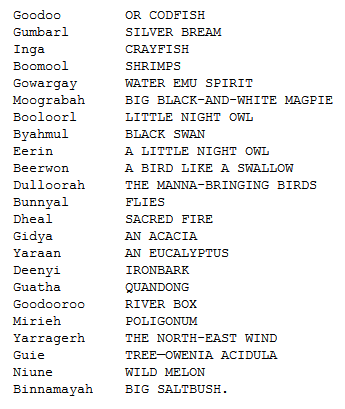
Bohrah, the kangaroo, is another totem, and is considered somewhat akin to Dinewan. For example, in a quarrel between, say, the Bohrah totem and the Beewee, the Dinewan would take the part of the former rather than the latter.
Amongst the multiplex totems of Bohrah are —
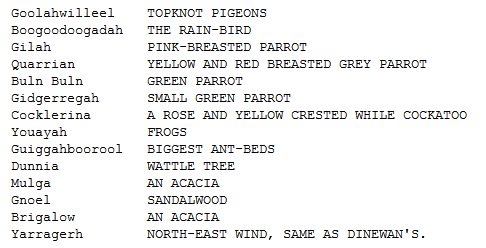
All clouds, lightning, thunder, and rain that is not blown up by the wind of another totem, belong to Bohrah.
Beewee, brown and yellow Iguana, numerically a very powerful totem, has for multiplex totems —
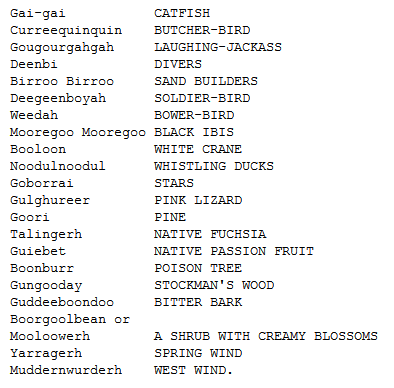
Those with whom the Beewee shares the winds he counts as relations. It is the Beewees of the Gwaimudthen, or dark blood, who own Yarragerh (spring wind); the light-blooded own Mudderwurderh (west wind).
Another totem is Gouyou, or Bandicoot. The animal has disappeared from the Narran district, but the totem tribe is still strong, though not so numerous as either the Beewees or Dinewans.
Multiplex totems of Gouyou —
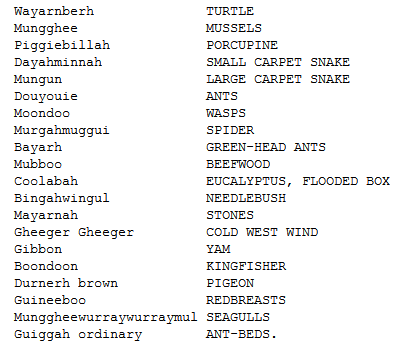
Next we take Doolungaiyah, or Bilber, commonly known as Bilby, a large species of rat the size of a small rabbit, like which it burrows; almost died out now. The totem clan are very few here too, so it is difficult to learn much as to their multiplex totems, amongst which, however, are —

Douyou, black snake, totem claims —
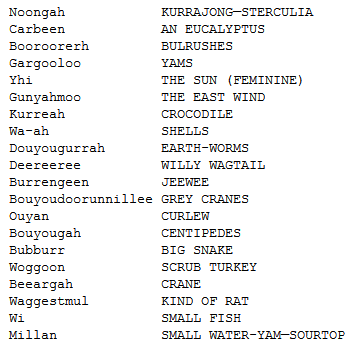
Moodai, or opossum, another totem, claims —
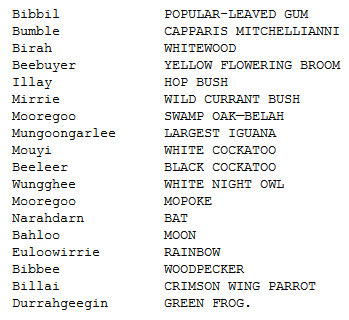
Maira, a paddy melon, claims as multiplex totems —
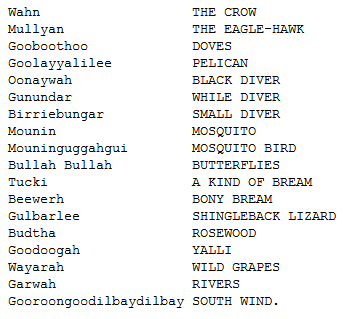
It is said a Maira will never be drowned, for the rivers are a sub-totem of theirs; but I notice they nevertheless learn to swim.
Yubbah, carpet snake, as a kin has almost disappeared, only a few members remaining to claim

Burrahwahn, a big sandhill rat, now extinct here, claims —
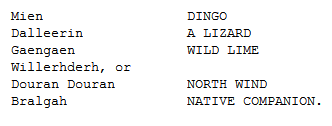
Buckandee, native cat kin, claim —

Amongst other totems were once the Bralgah, Native Companion, and Dibbee, a sort of sandpiper, but their kins are quite extinct as far as our blacks are concerned; the birds themselves are still plentiful. The Bralgah birds have a Boorah ground at the back of our old horse-paddock, a smooth, well-beaten circle, where they dance the grotesque dances peculiar to them, which are really most amusing to watch, somewhat like a set of kitchen lancers into which some dignified dames have got by mistake, and a curious mixture is the dance of dignity and romping.
The totem kins numerically strongest with us were the Dinewans, Beewees, Bohrahs, and Gouyous. Further back in the country, they tell me, the crow, the eaglehawk, and the bees were original totems, not multiplex ones, as with us.
It may be as well for those interested in the marriage law puzzles to state that Dinewans, Bohrahs, Douyous, and Doolungayers are always

That Moodai, Gouyou, Beewee, Maira, Yubbah are always

Our blacks may and do eat their hereditary totems, if so desirous, with no ill effects to themselves, either real or imaginary; their totem names they take from their mothers. They may, in fact, in any way use their totems, but never abuse them. A Beewee, for example, may kill, or see another kill, and eat or use a Beewee, or one of its multiplex totems, and show no sign of sorrow or anger, but should any one speak evil of the Beewee, or of any of its multiplex totems, there will be a quarrel.
There will likewise be a quarrel if any one dares to mimic a totem, either by drawing one, except at Boorahs, or imitating it in any way.
There are members of the tribes, principally wizards, or men intended to be such, who are given an individual totem called Yunbeai. This they must never eat or they will die. Any injury to his yunbeai hurts the man himself In danger he has the power to assume the shape of his yunbeai, which of course is a great assistance to him, especially in legendary lore; but, on the other hand, a yunbeai is almost a Heel of Achilles to a wirreenun (see the chapter on Medicine and Magic).
Women are given a yunbeai too, sometimes. One girl had a yunbeai given her as a child, and she was to be brought up as a witch, but she caught rheumatic fever which left her with St. Vitus's dance. The yunbeai during one of her bad attacks jumped out of her, and she lost her chance of witchery. One old fellow told me once that when he was going to a public-house he took a miniature form of his yunbeai, which was the Kurrea – crocodile – out of himself and put it safety in a bottle of water, in case by any chance he got drunk, and an enemy, knowing his yunbeai, coaxed it away. I wanted to see that yunbeai in a bottle, but never succeeded.
The differences between the hereditary totem or Dhe, inherited from the mother, and the individual totem or yunbeai, acquired by chance, are these: Food restrictions do not affect the totem, but marriage restrictions do; the yunbeai has no marriage restrictions; a man having an opossum for yunbeai may marry a woman having the same either as her yunbeai or hereditary totem, other things being in order, but under no circumstances must a yunbeai be eaten by its possessor.
The yunbeai is a sort of alter ego; a man's spirit is in his yunbeai, and his yunbeai's spirit in him.
A Minggah, or spirit-haunted tree of an individual, usually chosen from amongst a man's multiplex totems, is another source of danger to him, as also a help.
As Mr. Canton says: 'What singular threads of superstition bind the ends of the earth together! In an old German story a pair of lovers about to part chose each a tree, and by the tree of the absent one was the one left to know of his wellbeing or the reverse. In time his tree died, and she, hearing no news of him, pined away, her tree withering with her, and both dying at the same time.
Well, that is just what a wirreenun would believe about his Minggah. These Minggah and Goomarh spirit trees and stones always make me think, perhaps irrelevantly, of one of the restored sayings of the Lord, which ends 'Raise the stone, and there thou shalt find Me; cleave the wood, and I am there.'
Blacks were early scientists in some of their ideas, being before Darwin with the evolution theory, only theirs was a kind of evolution aided by Byamee. I dare say, though, the missing link is somewhere in the legends. I rather think the Central Australians have the key to it. One old man here was quite an Ibsen with his ghastly version of heredity.
He said, when I asked him what harm it would do for, say, a Beewee totem man to come from the Gulf country, where his tribe had never had any communication with ours, and marry a girl here, – that all Beewees were originally changed from the Beewee form into human shape. The Beewee of the Gulf, originally, like the Beewee here, had the same animal shape, and should two of this same blood mate the offspring would throw back, as they say of horses, to the original strain, and partake of iguana (Beewee) attributes either in nature or form.
From the statements just given, it will be seen that the Euahlayi are in the Kamilaroi stage of social organisation. They reckon descent in the female line: they have 'phratries' and four matrimonial classes, with totems within the phratries. In their system of 'multiplex-totems' or 'sub-totems' they resemble the Wotjobaluk tribe. [Howitt, NATIVE TRIBES OF SOUTH-EAST AUSTRALIA, pp. 121, 125, 453, 455.] The essence of the 'sub-totem' system is the division of all things into the categories provided by the social system of the human society. The arrangement is a very early attempt at a scientific system of classification.
Perhaps the most peculiar feature in the organisation of the Euahlayi is the existence of Matrimonial Classes, which are named as in the Kamilaroi tongue, while the phratry names are not those of the Kamilaroi, and alone among phratry names in Australia which can be translated, are not names of animals. The phratries have thus no presiding animals, and in the phratries there are no totem kins of the phratriac names. The cause of these peculiarities is matter of conjecture.
A peculiarity in the totemic system of the Euahlayi – the right of each individual to kill and eat his own totem – has been mentioned, and may be associated here with other taboos on food.
The wunnarl, or food taboo, was taken off a different kind of food for boys at each Boorah, until at last they could eat what they pleased except their yunbeai, or individual familiar: their Dhe, or family totem, was never wunnarl or taboo to them.
A child may not perhaps know that it has had a yunbeai given to it, and may eat of it in ignorance, when immediately they say that child sickens.
Should a boy or a girl eat plains turkey or bustard eggs while they were yet wunnarl, or taboo, he or she would lose his or her sight. Should they eat the eggs or flesh of kangaroo or piggiebillah, their skins would break out in sores and their limbs wither.
Even honey is wunnarl at times to all but the very old or very young. Fish is wunnarl for about four years after his Boorah to a boy, and about four months after she is wirreebeeun, or young woman, to a girl.
When the wunnarl was taken off a particular kind of meat, a wizard poured some of the melted fat and inside blood of that animal or bird, as the case might be, over the boy, and rubbed it into him. The boy, shaking and shivering, made a spluttering noise with his lips; after that he could eat of the hitherto forbidden food.
This did not necessarily refer to his totem, but any food wunnarl to him, though it is possible that there may have been a time in tribal history, now forgotten, when totems were wunnarl, and these ceremonies may be all that is left to point to that time.
When a boy, after his first Boorah, killed his first emu, whether it was his Dhe, or totem, or not, his father made him lie on the bird before it was cooked. Afterwards a wirreenun (wizard) and the father rubbed the fat on the boy's joints, and put apiece of the flesh in his mouth. 'The boy chewed it, making a noise as he did so of fright and disgust; finally he dropped the meat from his mouth, making a blowing noise through his lips of 'Ooh! Ooh! Ooh!' After that he could eat the flesh.
A girl, too, had to be rubbed with the fat and blood of anything from which the wunnarl was to be removed for her. No ceremony of this sort would be gone through with the flesh, fat, or blood of any one's yunbeai, or individual familiar animal, for under no circumstances would any one kill or eat their yunbeai.

